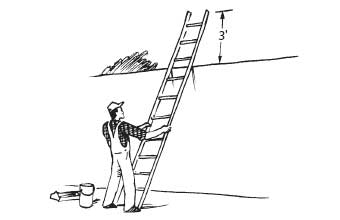You Can Prevent Ladder Accidents
Here are some key points.
- Carefully inspect your ladder before each use.
- Never climb a broken or damaged ladder.
- Use the right ladder for the job.
Why ladder accidents happen
- Ladders are pretty uncomplicated pieces of equipment.
- Yet each year, thousands of people are injured — and some are killed — when they fall from ladders, both on and off the job.
- Serious injuries and deaths also occur when people use metal ladders too close to electric power lines.
- Most ladder accidents can be prevented. They are typically caused by:
- using the wrong type of ladder for the job
- failing to inspect a ladder before use
- using a ladder incorrectly

Be sure the ladder is the proper height. And be sure it can handle the amount of weight it will need to handle for the job.

Be sure the ladder extends at least three feet beyond the top of the wall.

Stay off of the top two steps of a ladder. Don’t reach too far while you are on a ladder, and don’t try to move the ladder.
Before you use a ladder
- Be sure the ladder is the proper height. And be sure it can handle the amount of weight it will need to handle for the job.
- If you are uncertain about a ladder’s height or weight capacity, ask your supervisor.
- Check to see what the ladder is made out of. Never use a metal ladder near overhead power lines.
- Closely inspect the ladder. Look for:
- loose, missing or damaged steps or rungs
- oily or otherwise slippery steps or rungs
- loose nails, screws or bolts
- broken or missing braces
- damaged hinge spreaders
- dents in metal ladders
- cracks, splinters or evidence of rot in wooden ladders
- worn nonslip bases
- missing safety feet
- Ask your supervisor for a different ladder if you spot any problems.
Setting up a ladder
- Set up a ladder only on a firm, level, nonslip surface.
- If you are resting a ladder against a wall, position it so it’s parallel with the wall.
- The base of the ladder should be one foot away from the wall for every four feet of wall height.
- Be sure the ladder extends at least three feet beyond the top of the wall.
- Fully open all folding ladders and make sure locking devices are in place.
- Don’t set up a ladder in front of a door.
Safely using a ladder
- Ask someone to hold the bottom of your ladder before you climb it.
- Check your shoes. Make sure they have clean, dry, nonskid soles.
- Check for dangling shoelaces or pants legs that extend below your shoes.
- Use two hands when climbing a ladder. Keep at least one hand and both feet on the ladder while you are working.
- Mount the ladder from the center. And stay centered on the ladder while you’re working.
- Don’t carry hand tools or other items up a ladder. See your supervisor if you need help getting the items up.
- Stay off of the top two steps of a ladder.
- Don’t reach too far while you are on a ladder, and don’t try to move the ladder.
- Never allow more than one person on a ladder.
- Don’t store anything on a ladder.
Ladder Safety Do’s and Don’ts
Do
- Be sure the bottom of the ladder is secure before you climb it.
- Use a wooden or fiberglass ladder near power lines — not a metal ladder.
- Avoid reaching too far when you are on a ladder.
- Use boxes, a chair or anything else in place of a ladder.
- Walk under a ladder when someone is on it.
- Climb a ladder if you feel dizzy, ill or are afraid of heights.
Ladders
When you’re ready to work safely, you’re ready to work. See our full line of safety supplies, including respirators, eye and ear protection, coveralls, first aid and more.







